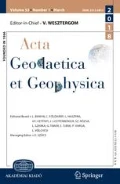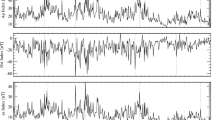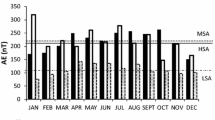Abstract
In the present study, information theoretic distance-based entropies have been employed for a better understanding of nonlinear features of the magnetosphere using proxies such as AE and Dst indices. Among the various distance-based entropies, approximate and sample entropies are considered as potential quantifiers which could track the nonlinear variations of the magnetospheric system. The generalized nonextensive Tsallis q-entropy and Fisher’s information measure are used to study the nonextensive entropy and complexity respectively of the magnetospheric dynamics. For the analysis, 1-min AE and Dst indices are considered during the period 1985–2007. The results indicate that nonlinearity and nonextensive entropy of Dst index are solar activity dependent. But, the nonlinearity and nonextensive measures of AE index are not having any solar activity dependence. This implies that, other than the modulating solar wind, certain other complex phenomena of internal origin are having influence on the dynamics of geomagnetic activity in the auroral zone.











Similar content being viewed by others
References
Ahn B-H, Kroehl HW, Kamide Y, Kihn EA (2000) Seasonal and solar cycle variations of the auroral electrojet indices. J Geophys Res 62:1301–1310
Akasofu S-I (2013) The relationship between the magnetosphere and magnetospheric/auroral substorms. Ann Geophys 31:387–394
Angelopoulos V, Kennel CF, Coroniti FV, Pellat R, Kivelson MG, Walker RJ, Russell CT, Baumjohann W, Feldman WC, Gosling JT (1994) Statistical characteristics of bursty bulk flow events. J Geophys Res 99:21257
Aschwanden M (2011) Self-organized criticality in astrophysics. Springer, Berlin
Bak P, Tang C, Weisenfeld K (1987) Self-organized criticality: an explanation of 1/f noise. Phys Rev A 38:364–374
Bak P, Tang C, Wiesenfeld K (1988) Self–organized criticality. Phys Rev A 38:364–374
Balan N, Alleyne H, Walker S, Réme H, Décréau PME, Balogh A, André M, Fazakerley AN, Cornilleau-Wehrlin N, Gurnett D, Fraenz M (2006) Cluster observations of a structured magnetospheric cusp. Ann Geophys 24:1015–1027
Balasis G, Daglis IA, Kapiris P, Mandea M, Vassiliadis D, Eftaxias K (2006) From pre-storm activity to magnetic storms: a transition described in terms of fractal dynamics. Ann Geophys 24:3557–3567
Balasis G, Daglis IA, Papadimitriou C, Kalimeri M, Anastasiadis A, Eftaxias K (2008) Dynamical complexity in Dst time series using non-extensive Tsallis entropy. Geophys Res Lett 35:L14102
Balasis G, Daglis IA, Papadimitriou C, Kalimeri M, Anastasiadis A, Eftaxias K (2009) Investigating dynamical complexity in the magnetosphere using various entropy measures. J Geophys Res 114:A00D06
Balasis G, Papadimitriou C, Daglis IA, Anastasiadis A, Sandberg I, Eftaxias K (2011) Similarities between extreme events in the solar-terrestrial system by means of nonextensivity. Nonlinear Process Geophys 18:563–572
Balasis G, Potirakis SM, Mandea M (2016) Investigating dynamical complexity of geomagnetic jerks using various entropy measures. Front Earth Sci 4:71
Chen J, Sharma AS, Edwards JW, Shao X, Kamide Y (2008) Spatiotemporal dynamics of the magnetosphere during geospace storms: mutual information analysis. J Geophys Res 113:A05217
Clilverd MA, Rodger CJ, Danskin D, Usanova ME, Raita T, Ulich T, Spanswick EL (2012) Energetic particle injection, acceleration, and loss during the geomagnetic disturbances which upset Galaxy. J Geophys Res 117:A12213
Colominas MA, Schlotthauer G, Torres ME, Flandrin P (2012) Noise-assisted EMD methods in action. Adv Adapt Data Anal 4:1250025
Consolini G (2002) Self-organized criticality: a new paradigm for the magnetotail dynamics. Fractals 10:275–283
Consolini G, Chang TS (2001) Magnetic field topology and criticality in geotail dynamics: relevance to substorm phenomena. Space Sci Rev 95:309–321
Consolini G, Marcucci MF, Candidi M (1996) Multifractal structure of auroral electrojet index data. Phys Rev Lett 76(21):4082–4085
Consolini G, De Michelis P, Tozzi R (2008) On the Earth’s magnetospheric dynamics: nonequilibrium evolution and the fluctuation theorem. J Geophys Res 113:A08222. https://doi.org/10.1029/2008JA013074
Consolini G, De Marco R, De Michelis P (2013) Intermittency and multifractional Brownian character of geomagnetic time series. Nonlinear Process Geophys 20:455–466. https://doi.org/10.5194/npg-20-455-2013
Consolini G, De Marco R, Carbone V (2015) On the emergence of a 1/k spectrum in the sub-inertial domain of turbulent media. Astrophys J 809:21
Davis TN, Sugiura M (1966) Auroral electrojet activity index AE and its universal time variations. J Geophys Res 71:785–801
Fisher RA (1925) Theory of statistical estimation. Proc Camb Philos Soc 22:700–725
Frieden BR (1998) Physics from Fisher information. Cambridge University Press, Cambridge
Frieden BR (2004) Science from Fisher information. Cambridge University Press, Cambridge
Fu HS, Cao JB, Zong Q-G, Lu HY, Huang SY, Wei XH, Ma YD (2012) The role of electrons during chorus intensification: energy source and energy loss. J Atm Sol Terr Phys 80:37
Ganon JL, Love JJ (2011) USGS 1-min Dst index. J Atm Sol Terr Phys 73:323–334
Gonzalez WD, Joselyn JA, Kamide Y, Kroehl HW, Rostoker G, Tsurutani BT, Vasyliunas VM (1994) What is a geomagnetic storm? J Geophys Res 99(A4):5771–5792
Gonzalez WD, Guarnieri FL, Gonzalez ALC, Echer E, Alves MV, Ogino T, Tsurutani BT (2006) Magnetospheric energetics during HILDCAA. In: Tsurutani BT et al. (eds) Recurrent magnetic storms: corotating solar wind streams. Geophys Monogr Ser, vol 167. AGU, Washington, D. C., https://doi.org/10.1029/167gm15
Gopinath S (2016) Multifractal features of magnetospheric dynamics and their dependence on solar activity. Astrophys Space Sci 361:290
Gopinath S, Prince PR (2016) Multiscale and cross entropy analysis of auroral and polar cap indices during geomagnetic storms. Adv Space Res 57:289–301
Gopinath S, Prince PR (2017) Multifractal characteristics of magnetospheric dynamics and their relationship with sunspot cycle. Adv Space Res 59:2265–2278
Gopinath S, Suji KJ, Prince PR (2015) Information measures based analysis of complex solar wind-magnetosphere interaction dynamics during geomagnetic storms. Indian J Phys 89(8):759–772
Guarnieri FL (2005) A study of the interplanetary and solar origin of high intensity long duration and continuous auroral activity events. Ph.D. thesis, Instituto Nacional de Pesquisas Espaciais, Sao Jose dos Campos, Brazil
Hajra R, Echer E, Tsurutani BT, Gonzalez WD (2013) Solar cycle dependence of high-intensity long-duration continuous AE activity (HILDCAA) events, relativistic electron predictors? J Geophys Res 118:5626–5638
Hiraki Y (2015) Auroral vortex street formed by the magnetosphere–ionosphere coupling instability. Ann Geophys 33:217–224
Huang NE, Wu Z (2008) A review on Hilbert–Huang transform: method and its applications to geophysical studies. Rev Geophys 46:1–23
Huang NE, Shen Z, Long SR, Wu MC, Shih HH, Zheng Q, Yen N-C, Tung CC, Liu HH (1998) The empirical mode decomposition and the Hilbert spectrum for nonlinear and non-stationary time series analysis. Proc R Soc Lond Ser A 454:903–993
Huang C-S, Foster JC, Reeves GD, Le G, Frey HU, Pollock CJ, Jahn J-M (2003) Periodic magnetospheric substorms: multiple space-based and ground-based instrumental observations. J Geophys Res 108:1411–1428
Lakhina GS (1994) Solar wind-magnetosphere–ionosphere coupling and chaotic dynamics. Surv Geophys 15:703–754
Li W, Thorne RM, Angelopoulos V, Bonnell JW, McFadden JP, Carlson CW, LeContel O, Roux A, Glassmeier KH, Auster HU (2009) Evaluation of whistler-mode chorus intensification on the nightside during an injection event observed on the THEMIS spacecraft. J Geophys Res 114:A00C14
Lui ATY (2002) Multiscale phenomena in the near-Earth magnetosphere. J Atmos Solar Terr Phys 64:125–143
Lui ATY, Chapman SC, Liou K, Newell PT, Meng CI, Brittnacher M, Parks GK (2000) Is the dynamic magnetosphere an avalanching system? Geophys Res Lett 27(7):911–914
Lundin R, Aparicio B, Yamauchi M (2001) On the solar wind flow control of the polar cusp. J Geophys Res 106:13023–13035
Mayer AL, Pawlowski CW, Cabezas H (2006) Fisher information and dynamic regime changes in ecological systems. Ecol Model 195:72–82
Milovanov AV, Zelenyi LM (2000) Functional background of the Tsallis entropy: “coarse-grained” systems and “kappa” distribution functions. Nonlinear Process Geophys 7:211
Nelson KP, Scannell BJ, Landau H (2011) A risk profile for information fusion algorithms. Entropy 13(8):1518–1532
Newell PT, Gjerloev JW, Mitchell EJ (2013) Space climate implications from substorm frequency. J Geophys Res 118:6254–6265
Osepian A, Kirkwood S, Smirnova N (1996) Energetic electron precipitation during auroral events observed by incoherent scatter radar. Adv Space Res 17:149
Pavlos GP, Karakatsanis LP, Xenakis MN, Sarafopoulos D, Pavlos EG (2012) Tsallis statistics and magnetospheric self-organization. Physica A 391(11):3069–3080
Pincus SM (1991) Approximate entropy as a measure of system complexity. Proc Natl Acad Sci USA 88:2297–2301
Pincus S (1995) Approximate entropy (ApEn) as a complexity measure. Chaos 5:110–117
Richman JS, Moorman JR (2000) Physiological time-series analysis using approximate and sample entropy. Am J Physiol 278:H2039–H2049
Sharma AS (1995) Assessing the magnetosphere’s nonlinear behavior: its dimension is low, its predictability, high. Rev Geophys 33:645–650
Sharma AS, Vassiliadis DV, Papadopoulos K (1993) Reconstruction of low-dimensional magnetospheric dynamics by singular spectrum analysis. Geophys Res Lett 20:335–338
Sitnov MI, Sharma AS, Papadopoulos K, Valdivia JA, Klimas AJ, Baker DN (2000) Phase transition-like behavior of the magnetosphere during substorms. J Geophys Res 105:12955–12974
Sitnov MI, Sharma AS, Papadopoulos K, Vassiliadis D (2001) Modeling substorm dynamics of the magnetosphere: from self-organization and self-organized criticality to nonequilibrium phase transitions. Phys Rev E 65:016116
Torres ME, Colominas MA, Schlotthauer G, Flandrin P (2011) A complete ensemble empirical mode decomposition with adaptive noise. In: ICASSP IEEE, pp 4144–4147
Tsallis C (1988) Possible generalization of Boltzmann–Gibbs statistics. J Stat Phys 52:479–488
Tsurutani BT, Gonzalez WD (1987) The cause of high intensity long-duration continuous AE activity (HILDCAAs): interplanetary Alfvén wave trains. Planet Space Sci 35:405
Tsurutani BT, Gonzalez WD, Guarnieri F, Kamide Y, Zhou X, Arballo JK (2004) Are high-intensity long-duration continuous AE activity (HILDCAA) events substorm expansion events? J Atmos Sol Terr Phys 66:167
Ukhorskiy AY, Sitnov MI, Sharma AS, Papadopoulos K (2003) Combining global and multi-scale features in a description of the solar wind-magnetosphere coupling. Ann Geophys 21:1913–1929
Ukhorskiy AY, Sitnov MI, Sharma AS, Papadopoulos K (2004) Global and multiscale dynamics of the magnetosphere. Geophys Res Lett 31:L08802. https://doi.org/10.1029/2003GL018932
Unnikrishnan K (2008) Comparison of chaotic aspects of magnetosphere under various physical conditions using AE index time series. Ann Geophys 26:941–953
Unnikrishnan K, Richards P (2014) How does solar eclipse influence the complex behavior of midlatitude ionosphere? Two case studies. J Geophys Res 119(2):1157
Uritsky VM, Pudovkin MI (1998) Low frequency 1/f-like fluctuations of the AE-index as a possible manifestation of self-organized criticality in the magnetosphere. Ann Geophys 16:1580
Uritsky VM, Klimas AJ, Vassiliadis D (2001) Comparative study of dynamical critical scaling in the auroral electro jet index versus solar wind fluctuations. Geophys Res Lett 28(19):3809–3812
Uritsky VM, Klimas AJ, Vassiliadis D, Chua D, Parks G (2002) Scale-free statistics of spatiotemporal auroral emissions as depicted by POLAR UVI images: dynamic magnetosphere as an avalanching system. J Geophys Res 107:1426
Valdivia JA, Rogan J, Muñoz V, Gomberoff L, Klimas A, Vassiliadis D, Uritsky V, Sharma S, Toledo B, Wastavino L (2005) The magnetosphere as a complex system. Adv Space Res 35:961–971
Valenza G, Allegrini P, Lanatà A, Scilingo EP (2012) Dominant Lyapunov exponent and approximate entropy in heart rate variability during emotional visual elicitation. Front Neuroeng 5:3
Vassiliadis DV, Sharma AS, Eastman TE, Papadopoulos K (1990) Low-dimensional chaos in magnetospheric activity from AE time series. Geophys Res Lett 17:1841–1844
Vörös Z, Jankovičová D, Kovács P (2002) Scaling and singularity characteristics of solar wind and magnetospheric fluctuations. Nonlinear Process Geophys 9:149–162
Wanliss JA, Dobias P (2007) Space storm as a phase transition. J Atmos Sol Terr Phys 69:675–684
Watanabe T-H, Kurata H, Maeyama S (2016) Generation of auroral turbulence through the magnetosphere–ionosphere coupling. New J Phys 18:125010
Wu Z, Huang NE (2009) Ensemble empirical mode decomposition: a noise-assisted data analysis method. Adv Adapt Data Anal 01:1–41
Zelenyi LM, Milovanov AV, Zimbardo G (1998) Multiscale magnetic structure of the distant tail: self-consistent fractal approach. In: Nishida A, Baker DN, Cowley SWH (eds) New perspectives on the earth’s magnetotail, Geophys Mon Ser 105 AGU 321
Živković T, Rypdal K (2012) Organization of the magnetosphere during substorms. J Geophys Res 117:A05212. https://doi.org/10.1029/2011JA016878
Zurek S, Guzik P, Pawlak S, Kosmider M, Piskorski J (2012) On the relation between correlation dimension, approximate entropy and sample entropy parameters, and a fast algorithm for their calculation. Phys A 391(24):6601–6610
Acknowledgements
The authors are thankful to World Data Center for Geomagnetism, Kyoto, Japan for providing 1-min auroral index data (http://wdc.kugi.kyoto-u.ac.jp/) and to USGS for providing 1-min Dst index data (http://geomag.usgs.gov/). The authors acknowledge SIDC for providing sunspot numbers (http://www.sidc.be/silso/datafiles). Authors would also like to thank the anonymous referee for providing valuable comments and suggestions which have led to significant improvement of the quality of the manuscript.
Author information
Authors and Affiliations
Corresponding author
Electronic supplementary material
Below is the link to the electronic supplementary material.
Rights and permissions
About this article
Cite this article
Gopinath, S., Prince, P.R. Nonextensive and distance-based entropy analysis on the influence of sunspot variability in magnetospheric dynamics. Acta Geod Geophys 53, 639–659 (2018). https://doi.org/10.1007/s40328-018-0235-y
Received:
Accepted:
Published:
Issue Date:
DOI: https://doi.org/10.1007/s40328-018-0235-y




